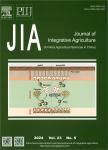Perspective of Chinese GF-1 high-resolution satellite data in agricultural remote sensing monitoring
Perspective of Chinese GF-1 high-resolution satellite data in agricultural remote sensing monitoring作者机构:Key Laboratory of Agri-informaticsMinistry of Agriculture/Institute of Agricultural Resources and Regional PlanningChinese Academy of Agricultural Sciences College of Urban & Environmental SciencesCentral China Normal University
出 版 物:《Journal of Integrative Agriculture》 (农业科学学报(英文版))
年 卷 期:2017年第16卷第2期
页 面:242-251页
核心收录:
学科分类:082804[工学-农业电气化与自动化] 08[工学] 0710[理学-生物学] 0832[工学-食品科学与工程(可授工学、农学学位)] 0830[工学-环境科学与工程(可授工学、理学、农学学位)] 1004[医学-公共卫生与预防医学(可授医学、理学学位)] 0828[工学-农业工程] 0905[农学-畜牧学] 0906[农学-兽医学] 0901[农学-作物学] 0703[理学-化学] 0902[农学-园艺学] 0713[理学-生态学]
基 金:financed by the National Natural Science Foundation of China (41501111 and 41271112) the National Non-profit Institute Research Grant of Chinese Academy of Agricultural Sciences (CAAS) (IARRP-2015-10)
主 题:GF-1 high resolution agricultural monitoring remote sensing CHARMS
摘 要:High-resolution satellite data have been playing an important role in agricultural remote sensing monitoring. However, the major data sources of high-resolution images are not owned by China. The cost of large scale use of high resolution imagery data becomes prohibitive. In pace of the launch of the Chinese "High Resolution Earth Observation Systems", China is able to receive superb high-resolution remotely sensed images (GF series) that equalizes or even surpasses foreign similar satellites in respect of spatial resolution, scanning width and revisit period. This paper provides a perspective of using high resolution remote sensing data from satellite GF-1 for agriculture monitoring. It also assesses the applicability of GF-1 data for agricultural monitoring, and identifies potential applications from regional to national scales. GF-1's high resolution (i.e., 2 m/8 m), high revisit cycle (i.e., 4 days), and its visible and near-infrared (VNIR) spectral bands enable a continuous, efficient and effective agricultural dynamics monitoring. Thus, it has gradually substituted the foreign data sources for mapping crop planting areas, monitoring crop growth, estimating crop yield, monitoring natural disasters, and supporting precision and facility agriculture in China agricultural remote sensing monitoring system (CHARMS). However, it is still at the initial stage of GF-1 data application in agricultural remote sensing monitoring. Advanced algorithms for estimating agronomic parameters and soil quality with GF-1 data need to be further investigated, especially for improving the performance of remote sensing monitoring in the fragmented landscapes. In addition, the thematic product series in terms of land cover, crop allocation, crop growth and production are required to be developed in association with other data sources at multiple spatial scales. Despite the advantages, the issues such as low spectrum resolution and image distortion associated with high spatial resolution and wide swath width, might pose challenges for GF-1 data applications and need to be addressed in future agricultural monitoring.



